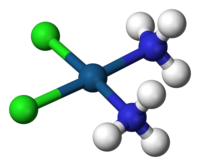
Photo from wikipedia
Manganese (Mn) is an important metal that is crucial in biological cell mechanism and function. However, its binding mechanism is poorly characterized. In the present study, we have carried out… Click to show full abstract
Manganese (Mn) is an important metal that is crucial in biological cell mechanism and function. However, its binding mechanism is poorly characterized. In the present study, we have carried out a detailed statistical analysis of the Mn-containing proteins through analysis of the metal coordination spheres of the vast number of protein crystal structures present in Protein Data Bank. These results reveal that Mn metal predominantly acquires the coordination number of six and five. In these predominant six and five coordination spheres, Mn metal is majorly stabilized with octahedral and square pyramidal geometries respectively. The water molecules, aspartic acid, and glutamic acid residues bonded frequently with Mn metal ions. These results provided useful insights to characterize the very important Mn-containing subset of the proteome. Quantum mechanical results showed that the complexes with coordination number six are predominantly having high interaction energy, which is in good agreement with statistical analysis.
Journal Title: Structural Chemistry
Year Published: 2020
Link to full text (if available)
Share on Social Media: Sign Up to like & get
recommendations!